How Is Ironman Going to Pull off Two Days of Racing in Kona?
This article originally appeared on Triathlete
It's been three years since the last Ironman World Championship race in Kona, though one would not be faulted for feeling like it's been much, much longer. After all, so much has happened in the world and in the sport since Jan Frodeno and Anne Haug broke the finish-line tape in 2019: a global pandemic, a postponed Olympic and Paralympic Games, record-breaking feats, a relocated world championship race in St. George, the retirement of beloved pros and the rise of a new crop of multisport stars. Through it all, Kona has been the marker for most triathletes as the return to normalcy – when triathlon's Super Bowl kicks off on the Big Island on October 6, many will breathe a sigh of relief.
But that doesn't exactly mean Kona will be picking up where it left off. A lot has changed during the last three years, and so too has the race, says Roch Frey, head of operations for Ironman world championship events. Frey, who oversees the Kona race with a team of race directors headed by Diana Bertsch, is planning a Kona comeback that honors the history of the beloved event while also looking to the future.
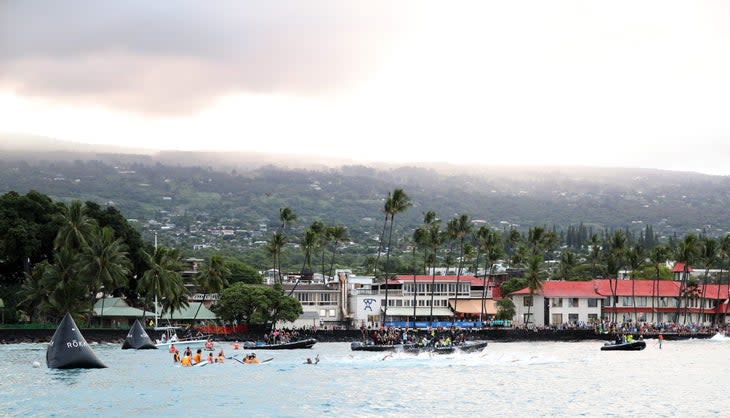
From event producer to community organizer
Shortly after the 2019 world championship race, Frey and his team were planning the 2020 event when they received news that all offices, including the Kona branch, would temporarily shut down during the pandemic to allow employees to shelter in place. Employees were worried, but like so many people in the initial days of the pandemic, there was an optimism that the pandemic would pass quickly and things would go back to normal. When that didn't happen, Frey says a rollercoaster of emotions kicked off for everyone:
"There were some cutbacks with staff, which was everywhere, and it was so quiet here in Kona," Frey says. "It was a completely different Kona."
For months, Frey held out hopes that the race would go on as planned in October of 2020, but when it became clear that wouldn't happen due to the ongoing spread of COVID, his focus shifted from organizing a race to organizing community support. With tourism on hold, Hawaii residents were struggling in a big way. Ironman, which is one of the largest organizations on the island, reached out to their vendors and contractors to find out how they could help.
"It wasn’t like we said, 'Okay, we’re done,' and we left the office the next day. It was a very busy several months for us," Frey says. "A big part of our work was supporting the community."
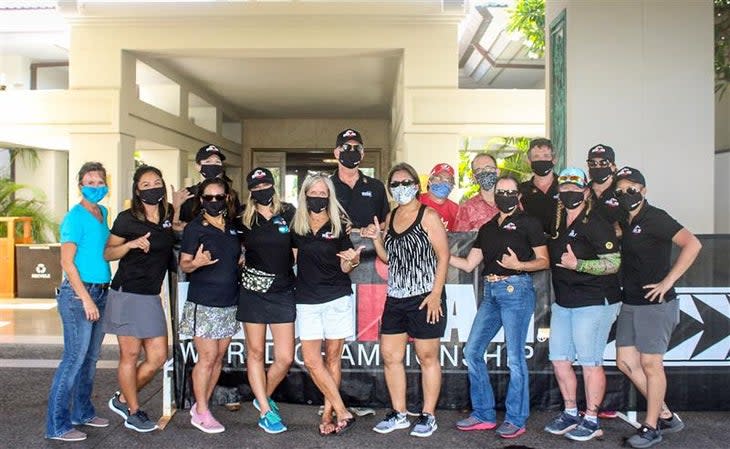
The organization's charity branch, the Ironman Foundation, spent more than a million dollars supporting residents on the big island. Frey and his team worked with race vendors to find out how they could offset the losses they were experiencing. Ironman purchased fresh fruits, vegetables, meats, and seafoods from local suppliers and set up "aid stations" around the Big Island to distribute food to residents in need – in all, over 80,000 meals.
"That kept us busy," Frey says. "And it was important to give back to our community. But through it all, we were really eager to get back to racing."
RELATED: How Kona Is Coping Without Ironman
On again, off again
In 2020, local officials told Ironman the race simply could not happen on the big island; with high case counts globally and limited hospital resources, Hawaii had imposed strict travel restrictions. Ironman agreed that safety came first, and postponed its 2020 event. Ironman and local government had every intention of putting on the race the following year, and when they got clearance to put on Ironman 70.3 Hawaii in June 2021 (albeit with strict COVID safety protocols), Frey and his team were optimistic the 2020 makeup race would happen in October of 2021.
"It was such an uplifting time. We started building our team back again, hiring new people. We were letting all our local agencies and vendors know it was coming back," Frey says. "We were working with suppliers to get everything set up, because you need to order things like medals and backpacks six months in advance."
But that race simply never happened. First, it was postponed to February of 2022. Then the 2020 race was canceled altogether. Instead, there would be a 2021 world championship makeup event more than 2,800 miles away in St. George, Utah – the first time in the event's history that the world championship was held somewhere other than Hawaii.
"We were on such a high, thinking we're going to have the world championship here [in 2021], and then it just took the wind out of our sails to learn we had to wait even longer," Frey says. "We went from such a high to such a low. We love doing this, we love the race."
As Frey's team set out to plan a first-ever world championship race in St. George, they also continued to keep the home fires burning in Kona by supporting the community in financial and practical ways. Food distribution continued, as did finding ways to keep their vendors employed. The backpacks Ironman had ordered for 2021 athletes were distributed to schools.
"There was a lot going on," Frey says.
RELATED: How St. George Became the New Kona
A homecoming – and a logistical nightmare
Though the race in St. George was a novel experience, there was an overwhelming sentiment from age-group and pro triathletes that Kona was where they wanted to be. Though they had been given the option to take a spot racing at the Utah event, many declined, preferring instead to hold on until the race returned to the big island. This backlog of athletes created a new problem for Ironman: How could they accommodate two years' worth of Kona qualifiers?
The central hub of the race is the Kona pier, a concrete platform that juts out into the ocean. The location serves as the swim start, transition area, and finish line. On an average day, the pier looks like a big piece of real estate, with multiple boats docking and plenty of people lined up for day tours to see dolphins or go snorkeling at the Captain Cook reefs. But on race day, the pier suddenly looks tiny, with row after row of triathlon bikes cramped together and a mass of humanity flowing from swim to bike to run.
"At maximum, we can fit 2,700 athletes on the pier," Frey says. "And with two years' worth of qualifying athletes, we had much more than that."
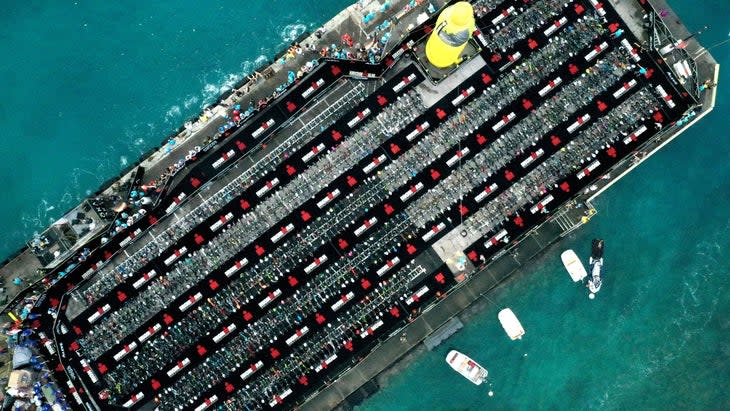
To accommodate the overstuffed list of athletes, Ironman officials approached local government with a proposal: Would it be possible to host two back-to-back days of racing?
The two-day format was not new to Ironman. Since 2017, the Ironman 70.3 World Championship has utilized a two-day structure, with women racing one day and men on the other. In addition to allowing more athletes to participate in the event, having separate days for men and women to race has allowed for more fair, clean racing without interference from other sexes. But the Ironman World Championship event has always been a one-day event. It's much easier to have back-to-back races when your races are only a few hours long; a 17-hour event like an Ironman cannot be turned over as quickly, so a two-day event would actually require three days: a race on the first day, breakdown and setup on the second, then a race on the third. It was a big ask, and Ironman knew it.
"The first step was going to the county, the mayor, and the local agencies to ask for their support," Frey says. "They knew we had this backlog of athletes. But they also knew the economic impact of this race, so we got the support from them right away."
That's not to say it was all enthusiastic – there was some pushback from some agencies, who expressed concerns about the logistics of taking over a significant part of the island for such a long period of time. There was also concern from local residents – traffic is already so restricted on race day, but to add another day and twice as many people felt like a hostile takeover to some. In response, Ironman hosted listening sessions with the communities most directly impacted by the race.
"We invited the public to come, and we educated them on Ironman, we educated them on the road closures and how it's going to affect them," Frey says. "We didn't sugarcoat it. We were clear: Hey, this is going to be crazy. During this time, you probably don't want to drive here. But we've got shuttle buses and resources to help you."
After these events, the sentiment changed. Suddenly, the public was all in. Part of it was due to the careful consideration Ironman had for locals when planning the event so traffic would not be impacted; many also warmed when they realized how much Ironman had done for the community during the pandemic and how much economic impact came with thousands of triathletes visiting the island.
Double the days, double the work
If the world championship race was a single day, as in the past, it's likely Frey and his team could probably pull out their 2019 plans and make just a few modifications for 2022. But a two-day event requires an entirely new playbook.
"This is the first time we’re doing two Ironman distances on the same course, and you just physically can’t do them two days in a row," Frey says. "You have to have a day in between."
On the first day of racing, Thursday, the final finisher will not be out of transition until 1 a.m. Friday morning. Almost immediately, a staff of more than 100 people will work the night shift, cleaning up the finish line area, turning over transition for the second day of athletes, and re-setting the staging area for the swim start on Saturday morning. Frey estimates they will be working until 10 in the morning on Friday. There will also be a crew taking down traffic barriers from the first race on Thursday so that Kona traffic can resume as usual on Friday; the barriers will be replaced before the second race begins on Saturday.
Doubling the race days will also require doubling the amount of support required to pull off the race. In all, 8,000 volunteers will be needed to have a successful event. Ironman has been working hard with local businesses, schools, and community groups to fill those volunteer spots and Frey says he is confident they will all be filled by race day.
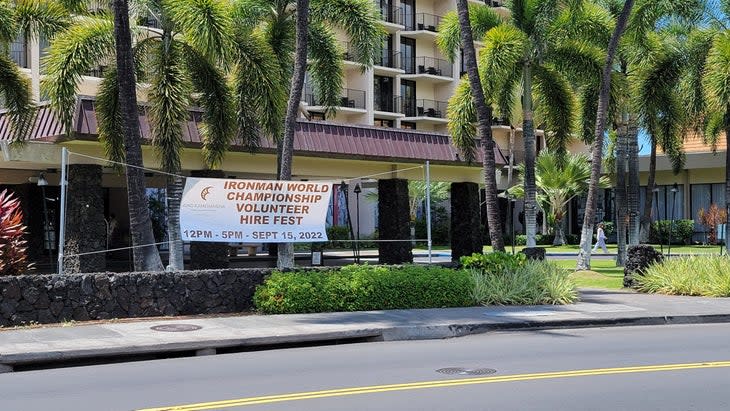
Layout and course changes
Another change to the race will be the layout; to fit all qualifying age-group athletes on the pier, the pro transition area has moved off the pier and onto the adjacent Ali'i Drive (where the finish line will also be set up). Because of this layout change, the mount line for athletes to start the bike will be moved 130 yards. Accordingly, the turnaround point for the bike leg in Hawi has moved 130 yards.
"It's very small," says Frey of the extension. "Most athletes probably won't even notice it. But we want to have the exact distance."
Another change to the course takes place at mile one of the bike leg, where athletes will take a small one-block detour around the Target Center; this allows community access to the old airport, which Ironman will be using for parking and one of two new shuttle locations for the race.
"We've got more than twice the amount of athletes, so we suspect more than twice the amount of spectators," Frey says. "There's no parking in town, so if people are driving in from their accommodations out of town, we need parking and shuttle bus systems to get them to the main part of town. That's where the old airport comes in. The other is at the old Kmart."
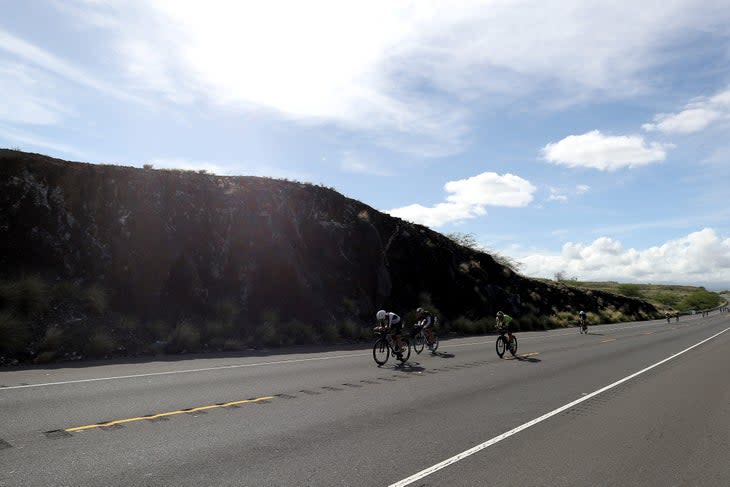
The final change to the course is also designed to accommodate the increased traffic that comes with such a large influx of athletes and spectators: Instead of shutting down all roads completely, certain areas will be open to traffic. On roads with four lanes of traffic, for example, Ironman will operate in the southbound lanes while vehicles will be allowed access to the northbound lanes.
"Local traffic can drive north, they can go to Costco, they can go to the business centers, get to the office if they need to or to the hotels and resorts," Frey says. "We wanted to keep it open more for the community."
To monitor the flow of traffic, more than 100 police officers will be managing key intersections along the course to keep vehicles and cyclists in their respective lanes.
The expensive reality of Kona
One significant change to the Kona experience this year is the cost of racing – though travel and accommodation costs to Hawaii have always been high, this year's race seems particularly costly for most. Flight prices are at an all-time high, and inflation has sent hotel costs skyrocketing. In the past three years, the homestay industry has exploded, and with it, costs of staying at vacation rentals. Add in a record number of tourists for the race, and many triathletes are finding the cost of traveling to the Ironman World Championships can be prohibitive. Some age-group and professionals have lamented they are being "priced out" of racing the iconic event, and it's a concern Frey says Ironman is taking seriously.
"We're seeing this concern everywhere, especially after the pandemic," Frey says. "There's a strong economic impact of this race, and when the race didn't happen for two years, that was a huge loss for many of these industries. We can't set the prices for a car rental or flight tickets or Airbnb, that's out of our control. But we are working with local visitor bureaus, local agencies, government agencies to see how we can make things more cost-effective for our athletes. And I think next year, once people realize, okay, I don't have to stay on Ali'i drive, I can stay 30 minutes out of town, there's something more economical and there are shuttle buses, things will start to change."
But at the end of the day, Frey is heartened by the enthusiasm of everyone – from government officials to locals to the athletes themselves – about the return of the race.
"We're back," Frey says. "It's been so busy since we got the go-ahead to actually have the race for sure. It's overwhelming, but so exciting at the same time."
RELATED: Updated: The 2022 Kona Ironman World Championship Pro Start List
For exclusive access to all of our fitness, gear, adventure, and travel stories, plus discounts on trips, events, and gear, sign up for Outside+ today.

